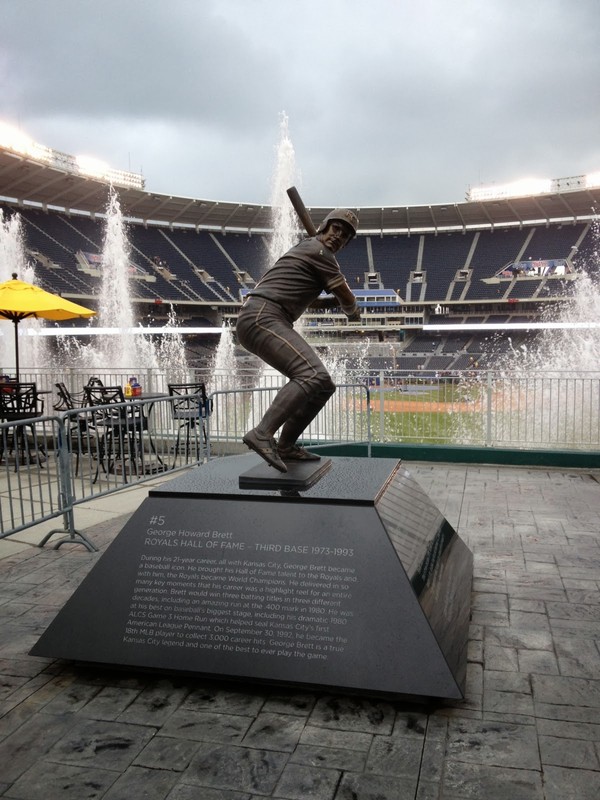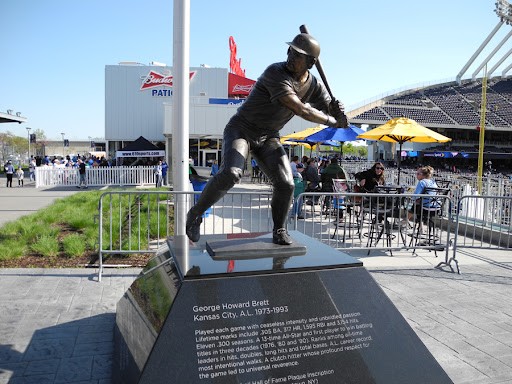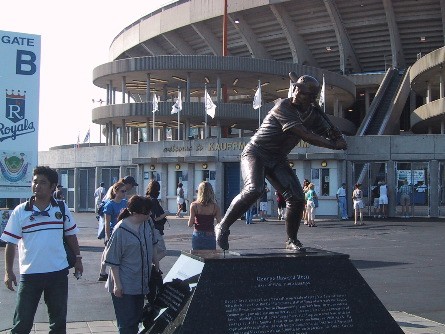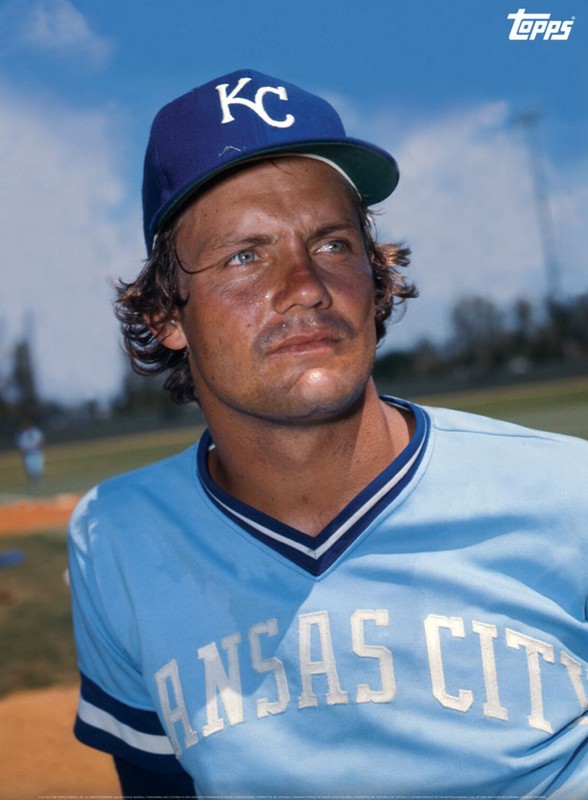George Brett Statue
Introduction
Text-to-speech Audio
This statue commemorates Kansas City Royals Hall of Famer George Brett (1953-). A native of West Virginia who grew up in southern California, he spent his entire twenty-one-year major league career with the organization. The only player to win three batting titles in three different decades, Brett also captured three Silver Slugger Awards, one American League Most Valuable Player Award, and one Gold Glove Award during his career. Following the 1993 season, the thirteen-time All-Star retired. Finishing with 3,154 hits, 317 home runs, and a .305 batting average, Brett is only one of four players in major league history with 3,000 hits, 300 home runs, and a .300 or greater career batting average. In 1999, the Baseball Writers’ Association of America elected him to the National Baseball Hall of Fame in his first year of eligibility. He remains the only player to represent the Royals in Cooperstown. On August 11, 2001, before their game against the Detroit Tigers, the Royals unveiled a statue of Brett outside Kauffman Stadium. Designed by artist Kwan Wu, the life-sized bronze sculpture fittingly depicts the club’s longtime third baseman at the plate. Dressed in his Royals uniform, with his bat cocked in his hands and his eyes focused on the incoming pitch, Brett picks up his right foot, beginning his hitting stride. In 2009, after Kauffman Stadium underwent significant renovations, the organization moved the statue inside the ballpark to the new right centerfield concourse.
Images
George Brett Statue in Kauffman Stadium

The bronze sculpture from another angle

The statue in its original location outside the ballpark

George Brett (1953-)

Backstory and Context
Text-to-speech Audio
George Howard Brett was born the youngest of four boys to Jack and Ethel Brett on May 15, 1953 in Glen Dale, West Virginia, just south of Wheeling. His father was a Brooklyn-born accountant who served in the U.S. Army during the Second World War. His mother was a bookkeeper for a furniture company. Like Brett, all three of his older brothers went on to play baseball professionally at some level. Ken, the Bretts’ second oldest, spent fourteen years in the majors with ten different teams as a pitcher. John and Bobby, the oldest and third oldest of the Brett brothers, respectively, both played for a time in the minor leagues. When George Brett was still a toddler, he and his family moved out west and settled in El Segundo, California. He later attended El Segundo High School, where he played on the school’s baseball and football teams.
In 1971, the Kansas City Royals selected Brett in the second round of that year’s Major League Baseball Draft. After a relatively brief stint in the club’s farm system, he made his major league debut on August 2, 1973 and won the starting role at third base the following season. Brett ultimately spent his entire twenty-one-year big league career with the Royals. In that time, he captured three American League batting titles and three Silver Slugger Awards. Brett’s best year came in 1980, when he nearly became the first player since Ted Williams in 1941 to finish with a batting average of .400 or better. Despite a late season slump that led him to finish the season with a .390 batting average, he nevertheless earned the American League Most Valuable Player Award. Five years later, Brett collected his first and only Gold Glove Award, and hit .335 with thirty home runs and 112 RBIs to power the Royals to the World Series, where he and his teammates defeated the Cardinals in seven games to clinch the franchise’s first World Series title. Following the 1993 season, the thirteen-time All-Star retired. Finishing with 3,154 hits, 317 home runs, and a .305 batting average, Brett is only one of four players in major league history (the others being Hank Aaron, Willie Mays, and Stan Musial) with 3,000 hits, 300 home runs, and a .300 or greater career batting average. In 1999, the Baseball Writers’ Association of America elected him to the National Baseball Hall of Fame in his first year of eligibility. He remains the only player to represent the Royals in Cooperstown.
On August 11, 2001, before their game against the Detroit Tigers, the Royals unveiled a statue of Brett outside Kauffman Stadium. Designed by artist Kwan Wu, the life-sized bronze sculpture fittingly depicts the club’s longtime third baseman at the plate. Dressed in his Royals uniform, with his bat cocked in his hands and his eyes focused on the incoming pitch, Brett picks up his right foot, beginning his hitting stride. In 2009, after Kauffman Stadium underwent significant renovations, the organization moved the statue inside the ballpark to the new right centerfield concourse.
Sources
Bergtold, Russell. "George Brett." sabr.org. Society for American Baseball Research. Web. 27 July 2021 <https://sabr.org/bioproj/person/george-brett/>.
Blevins, Dave. The Sports Hall of Fame Encyclopedia: Baseball, Basketball, Football, Hockey, Soccer. Volume 1. Lanham, MD: The Scarecrow Press, Inc., 2012.
"George Brett." baseballhall.org. National Baseball Hall of Fame. Web. 27 July 2021 <https://baseballhall.org/hall-of-famers/brett-george>.
"Kwan Wu." southwindfineart.com. Southwind Art Gallery. Web. 27 July 2021 <https://www.southwindfineart.com/artist/kwan-wu>.
Porter, David L., ed. Biographical Dictionary of American Sports. Baseball, A-F. Westport, CT: Greenwood Press, 2000.
https://ootlapba.com/tag/twins/
http://www.stadiumpage.com/stpages/Kauffman_Statue.html
https://slumberland.org/road_trip_2003/index-Pages/Image129.html
https://sabr.org/bioproj/person/george-brett/
